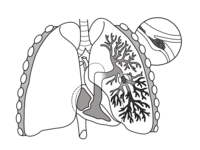
Photo from wikipedia
BackgroundThe present study aims to compare the pulmonary function of residents of Seoul special city (Seoul) and Jeju special self-governing province including Jeju city and Seogwipo city (Jeju), characterized by… Click to show full abstract
BackgroundThe present study aims to compare the pulmonary function of residents of Seoul special city (Seoul) and Jeju special self-governing province including Jeju city and Seogwipo city (Jeju), characterized by vastly different annual average airborne particulate matter with an aerodynamic diameter less ≤10 μm (PM10) concentrations, with the annual average PM10 concentration in Seoul being significantly higher than that in Jeju.MethodsThis cross-sectional study analyzed the pulmonary function test results and sociodemographic data of Korean adults ≥19 years of age derived from the 4th KNHANES, 2007–2009. A total of 830 individuals residing in Seoul or Jeju were included in this study. T-tests were used to analyze predicted values of forced expiratory volume in 1 sec (FEV1p), predicted values of forced vital capacity (FVCp) and FEV1/FVC ratio (FEV1/FVC), as dependent variables, to examine the differences in the subjects’ pulmonary function according to the city of residence. Stratified analysis was then performed to adjust for variables potentially affecting pulmonary function. The analysis was performed on subjects as a group and also following stratification according to sex and other variables.ResultsSeoul residents had a significantly lower FVCp than that of the Jeju residents (difference: 3.48%, p = 0.002). FEV1p, FVCp and FEV1/FVC of male Seoul residents were significantly lower than those of male Jeju residents (difference: 6.99, 5.11% and 0.03, respectively; p < 0.001, p = 0.001, p = 0.001). In male subjects, statistically significant results were obtained even after adjusting the influence of other variables through stratified analysis.ConclusionThe present analysis was based on cross-sectional data collected at one point in time. Therefore, unlike longitudinal studies, it does not establish a clear causal association between the variables. Nevertheless, this study found that pulmonary function among subjects residing in Seoul was significantly decreased compared to that of subjects residing in Jeju.
Journal Title: Annals of Occupational and Environmental Medicine
Year Published: 2018
Link to full text (if available)
Share on Social Media: Sign Up to like & get
recommendations!